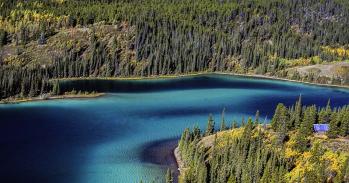
Scientists from the Scott Polar Research Institute (SPRI) have raised concerns regarding what they believe are erroneous claims of a 15% decrease in the permanent ice cover of Greenland in just 12 years.
Scientists from the Scott Polar Research Institute (SPRI) have raised concerns regarding what they believe are erroneous claims of a 15% decrease in the permanent ice cover of Greenland in just 12 years.
It is regrettable that the claimed drastic reduction in the extent of ice in Greenland has created headline news around the world. There is to our knowledge no support for this claim in the published scientific literature.
Dr Poul Christoffersen
The discrepancy was first brought to their attention via a media release accompanying the publication of the 13th edition of The Times Comprehensive Atlas of the World stating that the Atlas is ‘turning Greenland ‘green’’. Scientists from the Scott Polar Research Institute were extremely puzzled by this statement and the claim that ‘For the first time, the new edition of The Times Comprehensive Atlas of the World has had to erase 15% of Greenland’s once permanent ice cover – turning an area the size of the United Kingdom and Ireland ‘green’ and ice-free’. The scientists believe that the figure of a 15% decrease in permanent ice cover since the publication of the previous atlas 12 years is both incorrect and misleading.
SPRI scientists compared recent satellite images of Greenland with the new map and found that there are in fact still numerous glaciers and permanent ice cover where the new Times Atlas shows ice-free conditions and the emergence of new lands. Furthermore, the low-lying fringe of the main ice sheet appears to be shown as land, not ice. They concluded that a sizable portion of the area mapped as ice-free in the Atlas is clearly still ice-covered.
Dr Poul Christoffersen said: “It is regrettable that the claimed drastic reduction in the extent of ice in Greenland has created headline news around the world. There is to our knowledge no support for this claim in the published scientific literature.”
The scientists do not disagree with the statement that climate is changing and that the Greenland Ice Sheet is affected by this. They say, however, it is crucial to report climate change and its impact accurately and to back bold statements with concrete and correct evidence.
A close inspection of the new map of Greenland shows that elevation contours are noticeably different to the contours in an older map. Dr. Ian Willis and Toby Benham from SPRI were able to reproduce these contours using ice thickness data. It appears that the Times Comprehensive Atlas of the World may have used 500m ice thickness to map the ice sheet margin. If so, it is obviously an incorrect and flawed procedure.
The discrepancy between the new map of Greenland and very recent satellite images detected by SPRI are shown on the BBC website, http://www.bbc.co.uk/news/science-environment-14969399.
The Scott Polar Research Institute points out that the volume of ice contained in the Greenland Ice Sheet is approximately 2.9 million cubic kilometers and the current rate at which ice is lost is roughly 200 cubic kilometers per year. This is on the order of 0.1% by volume over 12 years. Numerous glaciers have retreated over the last decade, capturing the attention of scientists, policymakers and the general public. Because of this retreat, many glaciers are now flowing faster and terrain previously ice-covered is emerging along the coast - but not at the rate suggested in the media release accompanying the new edition of new The Times Atlas.
The SPRI scientists raising the alarm include: Dr. Poul Christoffersen, Prof. Julian Dowdeswell (Director), Mr. Toby Benham, Prof. Elizabeth M Morris, Dr. Ruth Mugford, Dr. Steven Palmer, Dr. Ian Willis.
This work is licensed under a Creative Commons Licence. If you use this content on your site please link back to this page.





